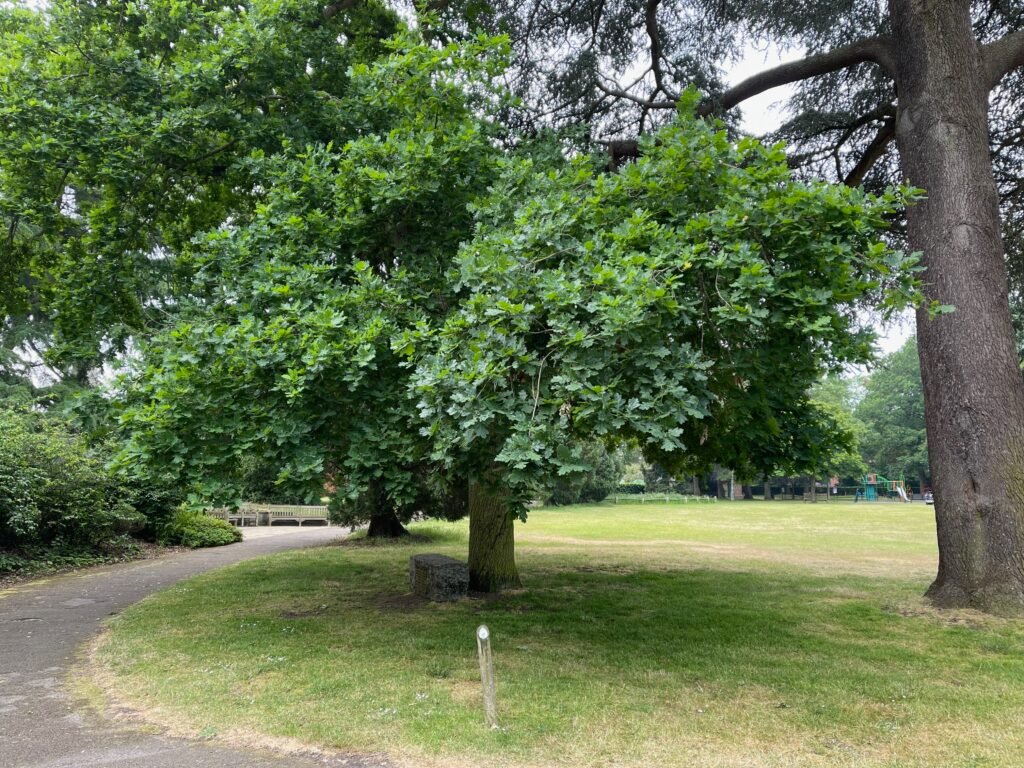Oak, English
The English Oak, the majesty of the woods, is a broadleaved deciduous tree, that can grow to a height of 40m, and may live for 1,000 years.
This species grows and matures to form a broad and spreading crown with sturdy branches beneath.
This tree was planted in memory of Mr Edward Holmes, who was the Trustees’ Clerk from the Gardens’ opening in 1888 until his death in 1908.

Photo supplied by: Alan Payne
Common Name:
English Oak
Scentific Name:
Quercus robur
Tree No:
143
Location:
L12

The leaves are round 10cm long with 4–5 deep lobes with smooth edges. Leaf-burst occurs mid-May and the leaves have almost no stem and grow in bunches.

Credit: This could be your image
Long, yellow hanging catkins which distribute pollen into the air.

Credit: This could be your image
The fruit is an acorn. The acorns are 2–2.5cm long, on long stalks and in cupules (the cup-shaped base of the acorn). As it ripens, the green acorn turns brown, loosens from the cupule and falls to the canopy below, sprouting the following spring.

Credit: This could be your image
English Oak is native to the UK. It is especially common in deciduous woods in southern and central Britain. In fact, it’s so frequent that it has assumed the status of a national emblem.
Oak forests support more life forms than any other native forest. They are host to hundreds of insect species, supplying many birds with an important food source. In autumn, mammals such as squirrels, badgers and deer feed on acorns.
Flower and leaf buds of English oak are the food plants of the caterpillars of butterflies.
The soft leaves of English oaks break down with ease in autumn and form a rich leaf mould beneath the tree, supporting invertebrates such as the stag beetle, and fungi, like the oak bug milk cap. Holes and crevices in the tree bark are perfect nesting spots for the pied flycatcher, redstart or marsh tit.
Oaks produce one of the hardest and most durable timbers on the planet. However, it takes up to 150 years before an oak is ready to use in construction. It has been a prized hardwood timber for thousands of years and is still used for wood framed buildings, doors, flooring, and furniture, as well as wine and sherry barrels, which are subsequently used for aging whisky.
An ancient example of Oak framed buildings can be seen at Cressing Temple Barns, where the Oak framed barns were built in the 13th century.
Ash, Elm and Oak, were used in the manufacture of cart wheels.
Oak is used for the spokes, because it doesn’t bend, compress or flex and transfers any load pressures directly from the felloes (rim) to the nave (hub).
It is interesting to see the difference of this tree from the Oak tree, planted 20 years before the Memorial Oak near the café. It is a much poorer specimen, due to the fact it was planted too close to the cedar – it is struggling to get up into the day light.
It goes to show how important it is, when planting trees, to consider how they will fare when their neighbours grow up!
Tree Listings
Lucombe Oak
Oak, Lucombe The Lucombe Oak, is a large spreading semi-evergreen tree, that can grow to a height of over 20m, and may live for 240 years. The bark is thick and corky and is fire resistant. Branches on older trees can be quite chunky. The buds are brownish, ovate...
Holme Oak
Oak, Holme The Holm Oak, is a broadleaf evergreen tree, that can grow to a height of over 20m, and may live for 400 years. The crown is broad, domed, with ascending branches and often with low stems. The bark is black and finely cracked, and the twigs are slender and...
English Oak
Oak, English The English Oak, the majesty of the woods, is a broadleaved deciduous tree, that can grow to a height of 40m, and may live for 1,000 years. This species grows and matures to form a broad and spreading crown with sturdy branches beneath. Photo...
Red Maple
Maple, Red The Red Maple, is a striking broadleaved deciduous tree, that can grow to a height of 20m, and may live for 200 years, although 80 to 100 years may be more typical. This tree was planted in memory of Mr Hungerford Rowley, a long and respected resident of...
Red Maple
Maple, Red The Red Maple, is a striking broadleaved deciduous tree, that can grow to a height of 20m, and may live for 200 years, although 80 to 100 years may be more typical. Photo supplied by: Alan PayneCommon Name:Red Maple Scentific Name:Acer rubrum Tree...
Norway Maple
Maple, Norway The Norway Maple, is a broadleaved deciduous tree, that can grow to a height of 25m, and may live for 150 years. The bark is grey with fine ridges, and the twigs are slender and brown with tiny white spots. Photo supplied by: Alan PayneCommon...
Norway Maple
Maple, Norway The Norway Maple, is a broadleaved deciduous tree, that can grow to a height of 25m, and may live for 150 years. The bark is grey with fine ridges, and the twigs are slender and brown with tiny white spots. Photo Supplied By: Alan PayneCommon...
Field Maple
Maple, Field The Field Maple, is a sturdy broadleaved deciduous tree, that can grow to a height of 20m, and may live for 350 years. The bark is light brown and flaky, and twigs are slender and brown and develop a corky bark with age. Small, grey leaf buds grow on long...
Common Lime
Lime, Common The Common Lime, a hybrid between small-leaved and large-leaved lime, is a broadleaved deciduous tree, that can grow to a height of 40m, and may live for 400 years. The bark is pale grey-brown and irregularly ridged, with characteristic large burrs and...
Horse Chestnut
Horse Chestnut The Horse Chestnut, with its shiny mahogany conkers, is a broadleaved deciduous tree, that can grow to a height of 40m, and may live for 300 years. The bark is smooth and pink-grey when young, which darkens and develops scaly plates with age. Twigs are...
English Elm
Elm, English The English Elm, is a deciduous tree, that can grow to a height of 30m, and may live more than 100 years. The bark is grey-brown, rough and fissured, often with suckers growing from the base of the trunk. The twigs are finely hairy. Photo supplied...
Lawson Cypress
Cypress, Lawson The Lawson Cypress, is an evergreen conifer, that can grow to a height of 45m high, and may live more than 500 years. A tall, narrowly conical tree, with feathery foliage. The bark is cracked into vertical plates, and the twigs are a dark...